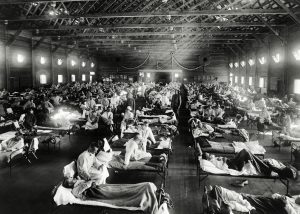
The Spanish Flu, which lasted from 1918 through 1919 (Cambridge University, 2018), was caused by the H1N1 virus, a strain of avian flu (CDC, n.d.). In an 18-month period, over one-third of the world’s population was infected and 3% of the world’s population (an estimated 50 million worldwide) died (CDC, n.d.). In many countries, including Canada, more people died of the Spanish Flu than during WWI (CDC, n.d.). Since the pandemic began during the last year of WWI, wartime media censorship led to inaccurate reporting of flu-related rates of infection and death. In early 1918, the only country reporting on widespread flu rates was Spain. As a result, the flu that caused the 1918 pandemic became known as the Spanish Flu (Eghigian, 2020; History Channel, n.d.; Little, 2020b). The origins and initial geographical starting point of the Spanish Flu remain a mystery (Cambridge University, 2018).

